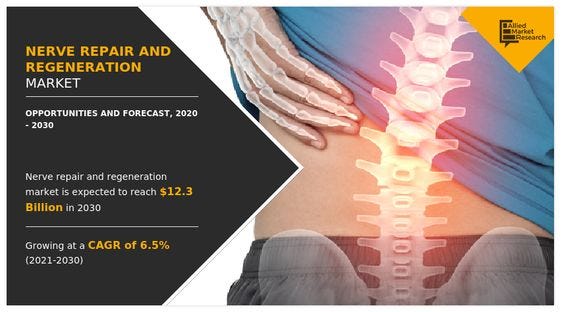Researchers from various universities and companies have been devising new ways to carry out nerve repair and regeneration. Innovative approaches and devices to speed up repair and regeneration processes of tissues and muscles have been launched. They aim to bring a paradigm shift and prove to be a boon for patients suffering from nerve damage. The demand for such methods and devices will increase in coming years. According to the report published by Allied Market Research, the global nerve repair and regeneration market is estimated to grow considerably over the next few years. Following are some of the activities taking place across the world.

Researchers have been able to develop tissues that would help people suffering from nerve injuries. Researchers from the Perelman School of Medicine at the University of Pennsylvania created injectable microtissue that has sensory and motor neurons. These neurons are enveloped in a protective tissue. These neurons are known as tissue engineered neuromuscular interfaces (TE-NMIs). They are sources of power to muscles in rat that suffered nerve injuries. In addition, they prevent loss and degeneration of function along with growing the damaged tissues. This method of regeneration provides protection of neurons and raises the possibility of connections of huge number of axons with muscles. It increases regenerative pathways. D. Kacy Cullen, PhD, one of the leading authors and an associate professor of Neurosurgery, highlighted that hundreds of thousands of patients suffer from nerve injuries every year and even after carrying out a perfect surgery, axon grow nearly one inch every month. So, they found a way to raise the time window to reconnect axons with muscles. This method will raise the recovery time for patients without incurring additional damage.
“North America is expected to dominate the global nerve repair and regeneration market during the forecast period. However, the market is growing at a faster rate in the developing countries, owing to the increase in the number of patients suffering from neurological diseases and improvement in the healthcare facilities”.
The nerve repair and regeneration products market includes biomaterials and neurostimulation and neuromodulation devices. The techniques of nerve repair and regeneration assist to cure the disorders such as Alzheimers disease, Parkinsons diseases, and other neurological diseases. Increase in geriatric population, rise in prevalence of neurological & epidemic disorders, and launch of innovative products for nerve repair & regeneration are the major factors that drive the market growth. However, stringent regulatory requirements for product approvals act as a restraining factor for the market growth. Increase in investment by major medical diagnostics giants and improvement in healthcare facilities in Asia-Pacific provide growth opportunities for the market.
The factors propelling the nerve repair and regeneration market are rise in geriatric population, growing prevalence of neurological and epidemic disorders, and introduction of novel and innovative products for nerve repair and regeneration. However, stringent regulatory requirements for product approvals, lack of skilled professionals, and high cost of the devices restrict the market growth. On the other hand, increase in investment by major medical diagnostics giants and improvement in healthcare facilities in Asia-Pacific are likely to offer immense growth opportunities to the market players.
With innovative methods, researchers have been developing devices for nerve repair. These devices have also gained an approval from regulatory bodies. A team of researchers from Australia developed Remplir. This device mimics the outer layer of peripheral nerve and enables nerve repair. Orthocell Ltd. is the developer of the device and the company gained a regulatory approval from the Australian Therapeutic Goods Administration for Remplir. The company outlined that this nerve repair and regeneration device is a paradigm shift in design and application of products for damaged peripheral nerves. It offers a barrier for protection of nerves and microenvironment for regeneration. In addition, it eliminates the need for suturing and provides consistent and predictable results when it comes to regaining muscle functions.
0 Comments